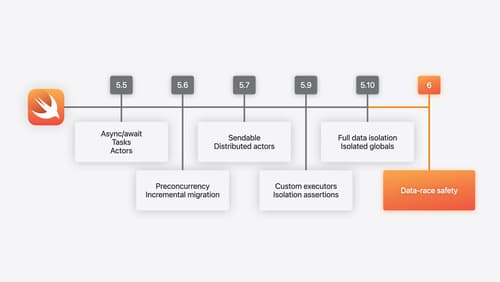Actor in sync code
Asked on 2024-08-02
1 search
Actors in Swift are a feature designed to help manage concurrency by protecting shared mutable state. They are similar to classes in that they are reference types, but they automatically serialize access to their state, ensuring that only one task can execute at a time on an actor. This helps prevent data races and makes concurrent programming safer and more manageable.
For example, in the session A Swift Tour: Explore Swift’s features and design, it is explained that actors can encapsulate shared mutable state and synchronize access to it. This means that calls to actor methods from outside the actor's context are asynchronous, and you need to use the await keyword to access them.
Additionally, in the session Migrate your app to Swift 6, it is mentioned that you can use the mainactor assume isolated method to tell the compiler that a particular piece of code is already running on the main actor, which avoids starting a new task and helps maintain performance.
Here are the relevant sessions mentioned:
If you have any more specific questions or need further details, feel free to ask!

What’s new in Swift
Join us for an update on Swift. We’ll briefly go through a history of Swift over the past decade, and show you how the community has grown through workgroups, expanded the package ecosystem, and increased platform support. We’ll introduce you to a new language mode that achieves data-race safety by default, and a language subset that lets you run Swift on highly constrained systems. We’ll also explore some language updates including noncopyable types, typed throws, and improved C++ interoperability.

Migrate your app to Swift 6
Experience Swift 6 migration in action as we update an existing sample app. Learn how to migrate incrementally, module by module, and how the compiler helps you identify code that’s at risk of data races. Discover different techniques for ensuring clear isolation boundaries and eliminating concurrent access to shared mutable state.

Meet TabletopKit for visionOS
Build a board game for visionOS from scratch using TabletopKit. We’ll show you how to set up your game, add powerful rendering using RealityKit, and enable multiplayer using spatial Personas in FaceTime with only a few extra lines of code.
